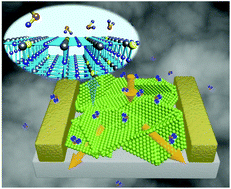High selectivity of sulfur-doped SnO2 in NO2 detection at lower operating temperatures†
Abstract
Resistive gas sensors based on metal oxides have aroused great interest in the sensing of NO2 gas due to their low cost, good stability, and easy fabrication. However, drawbacks such as low sensitivity and a lack of selectivity, which originate from the limited kinds of intrinsic active centers on the surface of the metal oxides that could be involved in the gas-sensing reaction, remain great challenges to overcome. To solve these problems, surface modification of SnO2 by S-doping was carried out by the sintering of flower-like SnS2. Gas-sensing tests revealed that the S-doped SnO2 showed ultra-high sensitivity to NO2 (Rg/Ra = 600 toward 5 ppm) with low optimal operating temperature (50 °C). The detection limit of the sensor was as low as 50 ppb (Rg/Ra = 11). Notably, the S-doped SnO2 showed negligible cross-responses to alcohol, acetone, HCHO, SO2, H2S, and xylene. The ultra-high sensitivity and selectivity toward NO2 were closely related to the content of the S-dopant. This phenomenon is attributed to the active role of S-dopant during the surface reactions with NO2, which was substantiated by in situ Raman characterization and DFT-based calculations. This study offers an important guide for surface modification by doping to improve the sensitivity and selectivity of metal oxides and sheds new light on material design to develop resistive gas sensors for NO2 detection.



 Please wait while we load your content...
Please wait while we load your content...